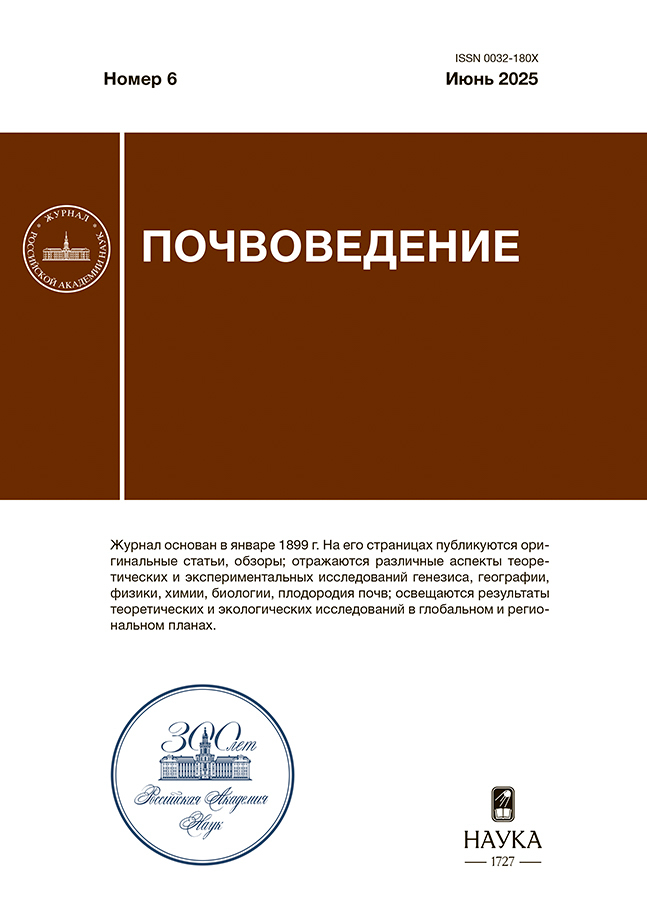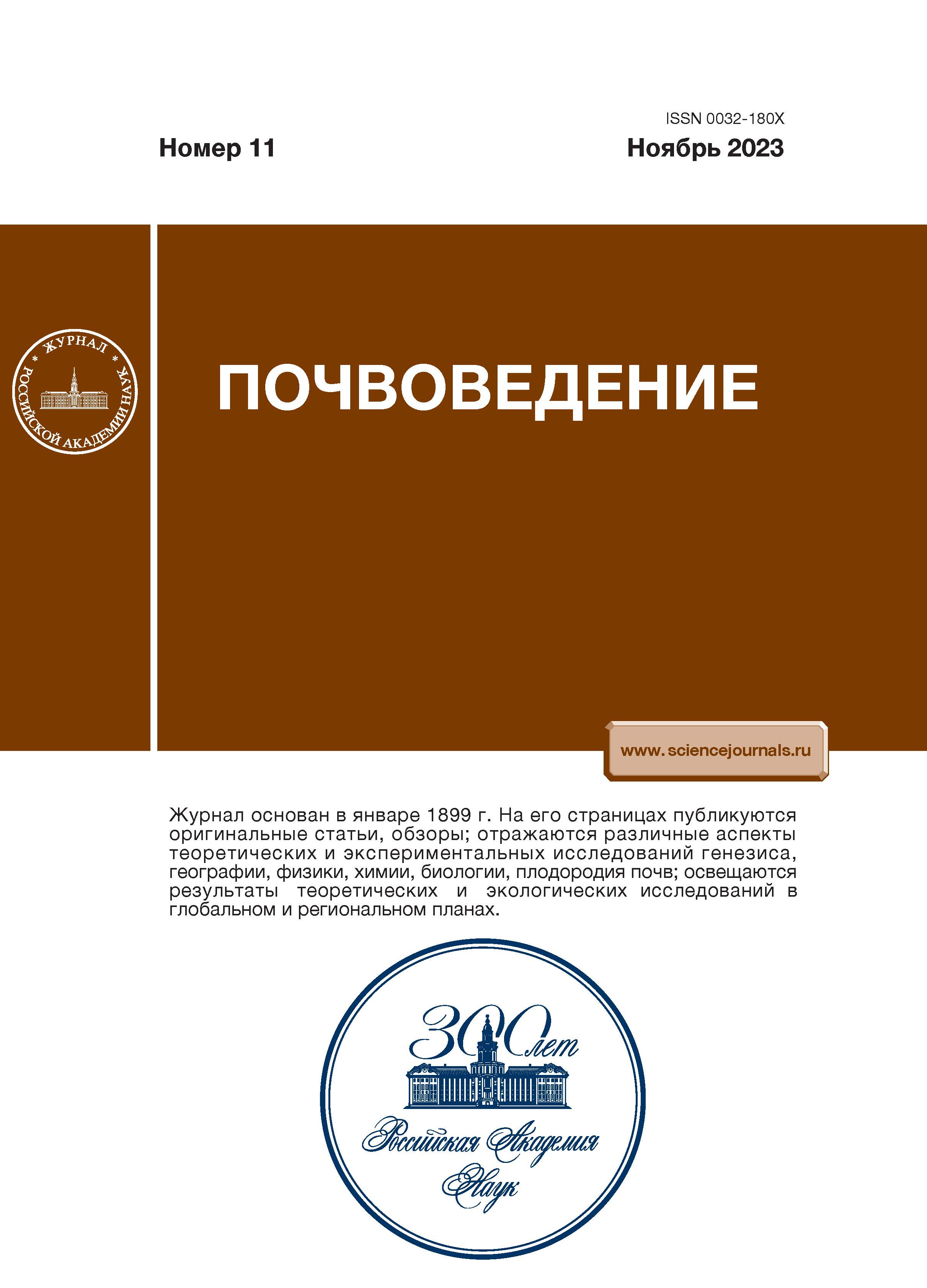Recognition of Rocky, Sandy and Calcareous Soils from the Surface in the South of the Volga Upland (Volgograd Oblast) from Satellite Images
- Authors: Gorokhova I.N.1, Khitrov N.B.1
-
Affiliations:
- Dokuchaev Soil Science Institute
- Issue: No 11 (2023)
- Pages: 1340-1356
- Section: GENESIS AND GEOGRAPHY OF SOILS
- URL: https://freezetech.ru/0032-180X/article/view/666724
- DOI: https://doi.org/10.31857/S0032180X23600609
- EDN: https://elibrary.ru/YILUEV
- ID: 666724
Cite item
Abstract
The purpose of the work is to recognize rocky, sandy and calcareous soils from the surface using a multi-zone satellite image in the south of the Volga Upland in the Volgograd oblast. The object of the study was the Volga-Don irrigation system, within the experimental station “Oroshayemaya”. The recognition was carried out by the spectral brightness of the space image of the bare soil surface in 4 bands. The most ranked values among them were marked in B1 band. Three catenae were studied, along which field information about soils was obtained. It was found that the greatest brightness (B1) is created by stones, rubble and sand scattered on the surface (970–1100 units). This is followed by: surface-effervescent soils with strongly rubbled rocks at a depth of about half a meter and sandy loam soils (710–830 units), with effervescence from the soil surface on mottled loams and sands of about half a meter (up to 700 units), and surface-calcareous soils, where mottled loams and sands occur deep (more than 70 cm), or with the absence of calcareous material in the surface horizons, with a brightness of 560–670 units. The use of this approach will enable more detailed recognition of soils on the basis of satellite imagery materials and separate surface-rocky and sandy soils from surface-calcareous soils, which are displayed in images with a similar spotty heterogeneity, but differ in spectral brightness.
About the authors
I. N. Gorokhova
Dokuchaev Soil Science Institute
Author for correspondence.
Email: g-irina14@yandex.ru
Russia, 119017, Moscow
N. B. Khitrov
Dokuchaev Soil Science Institute
Author for correspondence.
Email: khitrovnb@gmail.com
Russia, 119017, Moscow
References
- Антипов-Каратаев И.Н. Мелиорация солонцов в СССР. М.: Изд-во АН СССР, 1953. 563 с.
- Базовые шкалы морфологических элементов почв. Методическое руководство по описанию почв в поле. М.: Почв. ин-т им. В.В. Докучаева, 1982. 58 с.
- Барановская А.В., Азовцев В.И. Влияние орошения на миграцию карбонатов в почвах Поволжья // Почвоведение. 1981. № 10. С. 17–26.
- Волгоградская область: природные условия, ресурсы, хозяйство, население, геоэкологическое состояние. Волгоград: Перемена, 2011. 528 с.
- Высоцкий Г.Н. Ергеня: культурно-фитологический очерк // Тр. бюро по прикладной ботанике. Петроград: тип. К. Маттисена в Юрьеве, 1915. 331 с.
- Геологическая карта СССР (М 1 : 200 000), лист M-38-XXXIII. Всесоюзные аэрогеологический трест Министерства геологии СССР. М., 1968.
- Горохова И.Н., Панкова Е.И., Чурсин И.Н. Методические подходы к разработке мониторинга орошаемых земель юга Европейской части России на основе материалов космической съемки // Аридные экосистемы. 2020. Т. 26. С. 84–93. https://doi.org/10.24411/1993-3916-2020-10087
- Дегтярева Е.Т., Жулидова А.Н. Почвы Волгоградской области. Волгоград: Нижне-Волжское книжное изд-во, 1970. 319 с.
- Димо Н.А., Келлер Б.А. В области полупустыни: Почвенные и ботанические исследования на юге Царицинского уезда Саратовской губернии. Саратов: Изд-во Саратовского губернского земства, 1907. С. 3–185.
- Доклад о состоянии и использовании земель сельскохозяйственного назначения РФ в 2020 г. М., 2022. 384 с.
- Зимовец Б.А. Экология и мелиорация почв сухостепной зоны. М.: Почв. ин-т им. В.В. Докучаева, 1991. 248 с.
- Зинченко Е.В., Горохова И.Н., Круглякова Н.Г., Хитров Н.Б. Современное состояние орошаемых почв юга Приволжской возвышенности // Бюл. Почв. ин-та им. В.В. Докучаева. 2020. Вып. 104. С. 68–109. https://doi.org/10.19047/0136-1694-2020-104-68-109
- Иванова Е.И. Очерк почв южной части Подуральского плато и прилегающих районов Прикаспийской низменности. Л.: Изд-во АН СССР, 1928. 320 с.
- Иванова Е.Н., Фридланд В.М. Почвенные комплексы сухих степей и их эволюция // Вопросы улучшения кормовой базы в степной, полупустынной и пустынной зонах СССР. М.–Л.: Изд-во. АН СССР, 1954. С. 162–190.
- Карманов И.И. Спектральная отражательная способность и цвет почв как показатели их свойств. М.: Колос, 1974. 351 с.
- Классификация и диагностика почв России. Смоленск: Ойкумена, 2004. 342 с.
- Классификация и диагностика почв СССР. М.: Колос, 1977. 247 с.
- Любимова И.Н., Дегтярева Е.Т. Изменение карбонатного профиля почв солонцовых комплексов при агрогенном воздействии // Почвоведение. 2000. № 7. С. 855–860.
- Минашина Н.Г. Мелиорация засоленных почв. М.: Колос, 1978. 263 с.
- Орлов Д.С., Суханова Н.И., Розанова М.С. Спектральная отражательная способность почв и их компонентов. М.: Изд-во МГУ, 2001. 176 с.
- Полевой определитель почв России. М.: Почв. ин-т им. В.В. Докучаева, 2008. 182 с.
- Приходько В.Е. Орошаемые степные почвы: функционирование, экология, продуктивность. М.: Интеллект, 1996. 179 с.
- Роде А.А. Почвообразовательный процесс и эволюция почв. М.: Географгиз, 1947. 142 с.
- Руководство по описанию почв. Рим. Продовольственная и сельскохозяйственная организация объединенных наций, 2012. 101 с.
- Сиземская М.Л. Современная природно-антропогенная трансформация почв полупустыни Северного Прикаспия. М.: Товарищество научных изданий КМК, 2013. С. 276.
- Симакова М.С. Методика картирования почв Прикаспийской низменности по материалам аэрофотосъемки // Почвенно-географические исследования и использование аэрофотоснимков в картографировании почв. М.: Изд-во АН СССР, 1959. С. 283–357.
- Панкова Е.И., Мазиков В.М. Методические вопросы использования аэрофотоснимков для характеристики засоления почв // Почвенно-мелиоративные процессы в районах нового орошения. Науч. тр. Почв. ин-та им. В.В. Докучаева. М., 1975. С. 97–111.
- Вышивкин Д.Д. Географическая интерпретация космических снимков в целях тематического картирования засоленных земель // Исследования природной среды космическими средствами М.: ВИНИТИ, 1975. Т. 4. С. 34–37.
- Антонова С.Ю., Кравцова В.И. Опыт использования космических многозональных снимков для изучения засоления территории // Исследования природной среды космическими средствами М.: ВИНИТИ, 1976. С. 131–139.
- Хитров Н.Б., Горохова И.Н., Панкова Е.И. Дистанционная диагностика содержания карбонатов в орошаемых почвах сухостепной зоны Волгоградской области // Почвоведение. 2021. № 6. С. 657–674. https://doi.org/10.31857/S0032180X21060071
- Jia-ge Chen, Jun Chen, Qin-jun Wang, Yue Zhang, Hai-feng Ding, Zhang Huang. Retrieval of Soil Dispersion Using Hyperspectral Remote Sensing // Indian Soc. Remote Sensing. 2016. V. 44. P. 563–572.
- Medeiros Pessoa L.G., Galvão Dos Santos Freire M.B., Wilcox B.P., Machado Green C.H., Tolêdo De Araújo R.J., De Araújo Filho J.C. Spectral reflectance characteristics of soils in northeastern Brazil as influenced by salinity levels // Environ. Monitoring Assessment. 2016. V. 188. P. 616.
- Myers V.J., Carter D.L., Rippert W.G. Remote sensing for estimate soil salinity // J. Irrigation Drainage Division. 1966. V.4. P. 59-68.
- Ren D., Wei B., Xu X., Engel B., Li G., Huang Q., Xiong Y., Huang G. Analyzing spatiotemporal characteristics of soil salinity in arid irrigated agro-ecosystems using integrated approaches // Geoderma. 2019. V. 356. P. 113935. https://doi.org/10.1016/j.geoderma.2019.113935
- Richardson J.A. Detection of soils with sky lab multispectral, scanner date program // Eng. And Remote Sensing. 1976. V. 5. P. 679-684.
- Wang F., Shi Z., Biswas A., Yang S., Ding J. Multi-algorithm comparison for predicting soil salinity // Geoderma. 2020. V. 365. P. 114211. https://doi.org/10.1016/j.geoderma.2020.114211
- IUSS Working Group WRB. World Reference Base for Soil Resources 2014, update 2015. International soil classification system for naming soils and creating legends for soil maps. World Soil Resources Reports. 2015. No. 106. FAO, Rome. 192 p.
Supplementary files
















